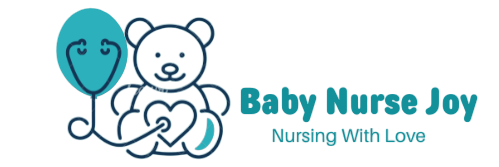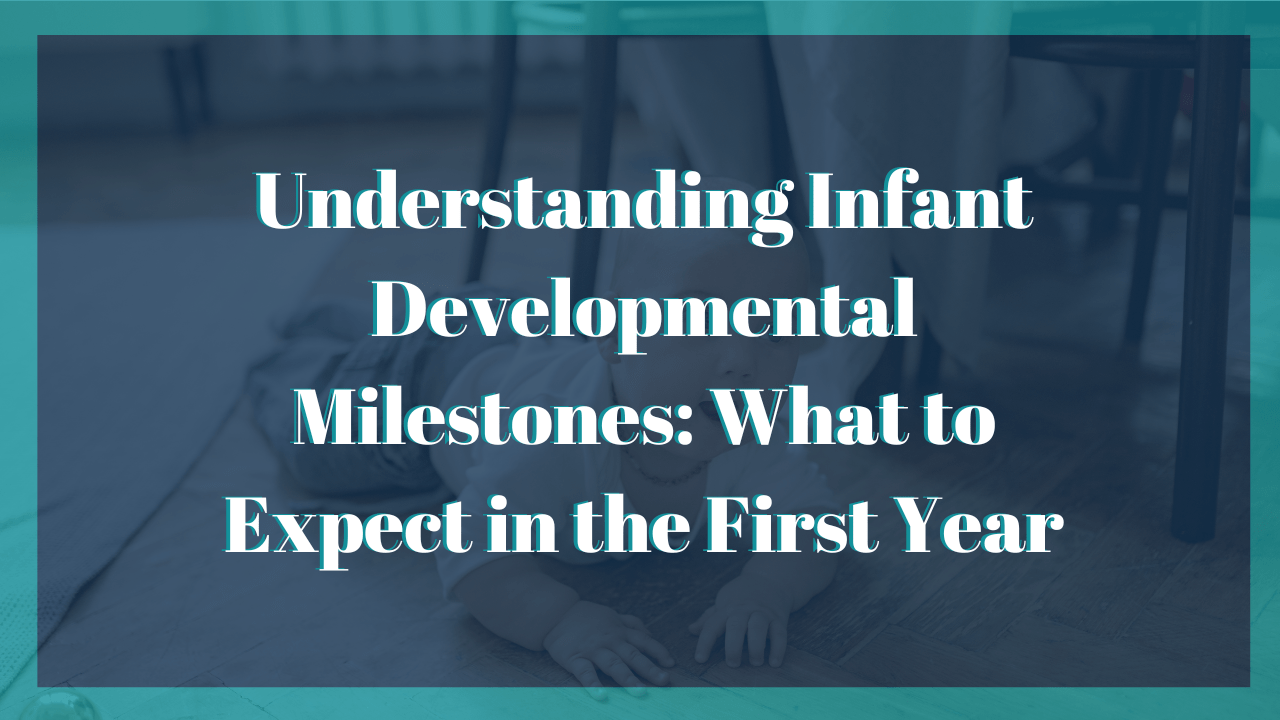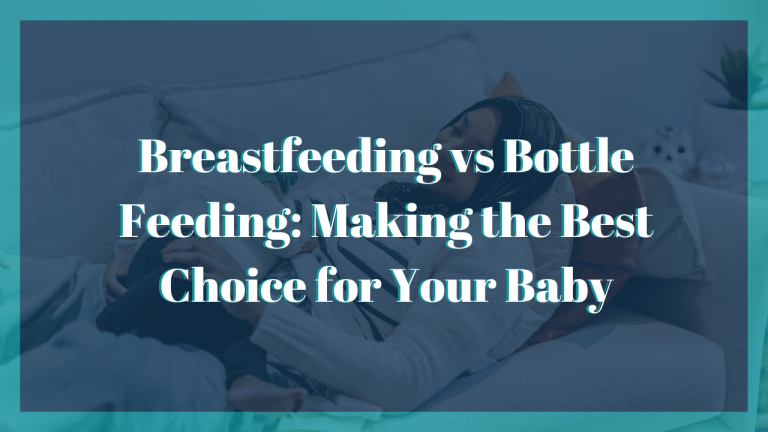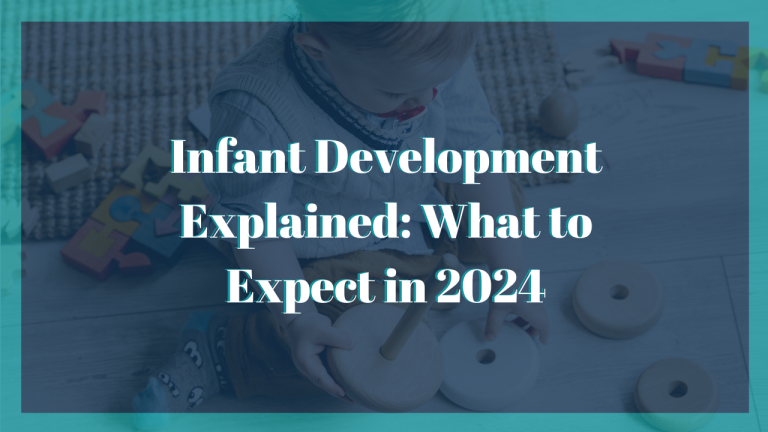Understanding Infant Developmental Milestones: What to Expect in the First Year
Watching your baby grow and change during their first year is miraculous! Every month brings new developments, from their first smile to their first steps. Understanding these infant developmental milestones can help you track your baby’s progress and give you peace of mind as you navigate parenthood. This guide will walk you through what to expect each month, offering tips on nurturing your baby’s growth and development. So, let’s dive in and explore the incredible journey of your baby’s first year!
Newborn (0-1 Month): Adjusting to the World

The first month of your baby’s life is a period of immense change and adaptation. As your newborn adjusts to life outside the womb, you’ll notice a series of instinctual behaviors known as newborn reflexes. These reflexes, like rooting and grasping, are crucial for survival and are among the earliest developmental milestones. For instance, the rooting reflex helps your baby find your breast or a bottle, turning their head toward any touch on their cheek. Meanwhile, the grasping reflex allows them to hold onto your finger tightly, which can be a deep bonding experience.
One of the most important aspects of caring for your newborn is skin-to-skin contact. This practice involves placing your baby on your bare chest, promoting warmth, security, and bonding. Skin-to-skin contact is known to regulate your baby’s body temperature, heart rate, and breathing, making it a vital practice, especially in the early days. Additionally, it can help stimulate feeding reflexes, aiding in the establishment of breastfeeding routines, which is another key developmental milestone in this early stage.
Feeding routines play a significant role during this time. Whether you’re breastfeeding or formula feeding, newborns typically need to eat every 2-3 hours. Establishing a feeding routine can be challenging, but it’s essential for your baby’s growth and development. Monitoring your baby’s weight gain and diaper output can help you ensure they’re hitting important developmental milestones and getting enough nourishment.
Sleep patterns in newborns are erratic and often unpredictable. During the first month, your baby might sleep anywhere from 16 to 20 hours a day, broken into short periods of 2-4 hours. These frequent wake-ups are normal and necessary, as they need to be fed regularly. To help manage this, try to create a calming sleep environment by keeping the room dark and quiet. Swaddling can also mimic the snug feeling of the womb, which may help your baby sleep better.
As your baby adjusts to their new surroundings, you’ll also begin to notice early signs of sensory development. While their vision is still blurry, newborns can see objects and faces about 8-12 inches away, which is typically the distance to your face during feeding. Your baby might also respond to loud noises by startling, and they’ll likely show a preference for your voice. Engaging with your newborn through gentle talking, singing, and maintaining eye contact can help strengthen these early sensory connections.
Understanding these developmental milestones in your newborn’s first month can help you support their growth and adaptation to the world outside the womb. Every baby develops at their own pace, so focus on nurturing their needs and creating a comforting, secure environment. The first month is just the beginning of an incredible journey!
One Month: Becoming More Alert
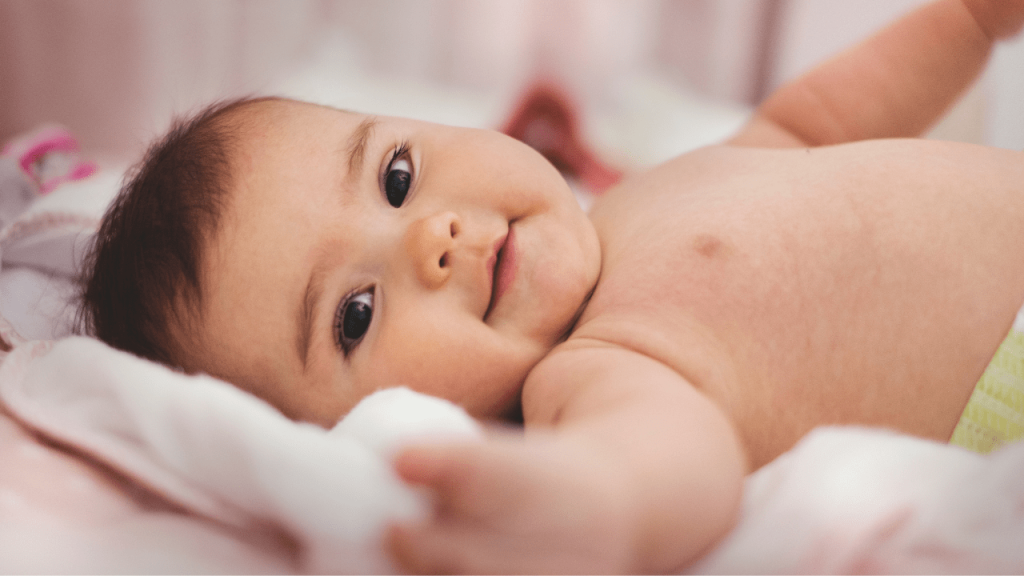
As your baby enters their second month of life, you’ll notice they’re starting to become more alert and engaged with their surroundings. This newfound awareness is an exciting milestone in your baby’s infant developmental stages, as they begin to stay awake for longer periods and start exploring the world with curiosity.
One of the first changes you might observe is increased alertness during wakeful periods. While your baby still sleeps a lot, the time they spend awake is more focused. Your baby will start to fixate on objects, especially faces, and might even follow them with their eyes. This development in visual tracking is a sign that their eyesight is gradually improving, though it will still be a few more months before they can see clearly. During this time, tracking visual and auditory responses becomes a key activity, helping you monitor your baby’s sensory development.
Tummy time is crucial at this stage for developing your baby’s neck and shoulder muscles, which are essential for later milestones like rolling over and sitting up. Start by placing your baby on their tummy for short periods, about 1-5 minutes a few times a day. Not only does this help build muscle strength, but it also gives them a different perspective of the world, fostering both early motor skills and sensory exploration. Remember to always supervise tummy time and ensure your baby is placed on a safe, soft surface.
At one month, bonding through eye contact and talking becomes even more important. Your baby may start to recognize your voice and turn their head toward you when you speak. This is an early sign of language development, even though they’re not yet ready to form words. Engaging with your baby by narrating your day or singing lullabies helps strengthen the bond between you and also supports their emerging communication skills.
Another exciting development at this stage is the appearance of early social smiles. While newborns often smile due to reflexes, at around one month, you may notice your baby starting to smile in response to your voice or face. These social smiles are one of the first signs that your baby is beginning to engage with others, a critical part of their social development.
The one-month mark is a period of increasing awareness and interaction for your baby. As they become more alert, you’ll have more opportunities to engage with them, whether through tummy time, eye contact, or responding to their early attempts at communication. Each of these activities plays a vital role in supporting your baby’s ongoing growth and development as they continue to adapt to the world around them.
Two Months: The First Social Smiles

By the time your baby reaches two months, one of the most heartwarming developmental milestones occurs: the first social smiles. Unlike the reflexive smiles that appeared earlier, these are true social smiles, a sign that your baby is beginning to recognize and respond to the world around them. These smiles are an early indication of social development and mark the beginning of your baby’s journey into more complex emotional and social interactions.
These first social smiles are your baby’s way of communicating happiness and pleasure, usually in response to seeing your face, hearing your voice, or engaging with other familiar stimuli. It’s an incredible moment for parents, as these smiles are a tangible sign that your baby is starting to connect with you and recognize your presence. Responding to these smiles with your positive facial expressions, words, and laughter helps to reinforce this new behavior, fostering a strong emotional bond between you and your baby.
At two months, your baby will also begin to experiment with vocalizations like cooing and other sounds. These early attempts at communication are essential components of their developmental milestones, particularly in language development. When your baby coos or makes other sounds, it’s their way of engaging with you, inviting you to interact. By responding to these sounds with gentle talking or mimicry, you encourage your baby’s efforts and help lay the foundation for future speech. This back-and-forth exchange of sounds and smiles is a key aspect of early communication development.
Tummy time continues to be important at this stage, as your baby’s neck muscles grow stronger and their ability to lift their head improves. By now, your baby might start to push up on their arms during tummy time, which is crucial for developing early motor skills like rolling over and eventually sitting up. As your baby gains more head control, their perspective of the world expands, allowing them to become even more engaged with their surroundings. This improved neck strength also aids in hand-eye coordination, as your baby begins to reach for objects while lying on their stomach—another important developmental milestone.
During this period, you might also notice your baby’s hands becoming more active. While they may not yet have the fine motor control to grab and hold objects for extended periods, they will begin to open and close their hands more deliberately. These early hand movements are a sign that your baby’s motor skills are advancing. Providing your baby with soft, lightweight toys that they can grasp during playtime helps further develop these skills.
Finally, the two-month mark often brings the first noticeable growth spurt. This period of rapid growth can lead to increased fussiness and a greater need for comfort and food. Soothing your baby during these growth spurts is essential; gentle rocking, swaddling, and feeding on demand can help your baby through these sometimes challenging times. Remember, growth spurts are a normal part of your baby’s development, and they signal that your little one is growing well.
The second month of your baby’s life is filled with significant developmental milestones that reflect their growing social engagement and motor development. The first social smiles, combined with increased vocalizations and improved head control during tummy time, show that your baby is starting to connect more deeply with the world around them. By engaging with and supporting your baby through these developments, you play an essential role in nurturing their continued growth and happiness.
Three Months: Building Strength and Coordination
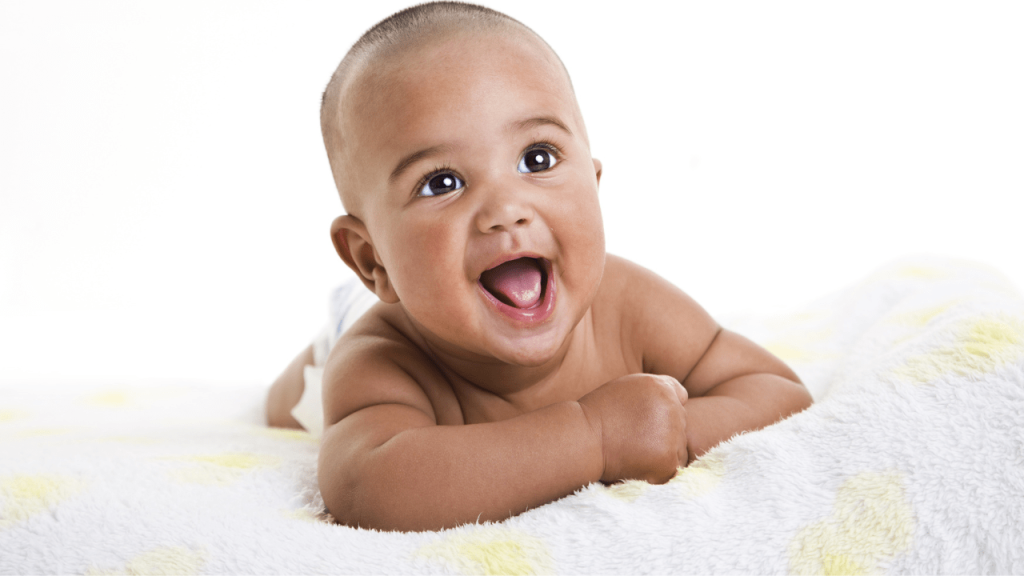
As your baby reaches the three-month mark, you’ll observe significant progress in their physical development, particularly in terms of strength and coordination. This stage is all about gaining more control over their body, which lays the groundwork for future milestones like rolling over, sitting up, and eventually crawling.
One of the most noticeable developments at three months is improved head control. By now, your baby should be able to hold their head up steadily when you hold them upright. This is a huge leap from the earlier days when their neck muscles were still developing. The strengthening of these muscles is primarily due to consistent tummy time, which encourages your baby to lift their head and look around. This activity not only strengthens the neck but also the shoulder and upper back muscles, all of which are crucial for later motor skills.
With better head control, your baby’s hand-eye coordination also starts to improve. You might notice your baby reaching for objects more intentionally, though they may not always succeed in grabbing them. This reaching behavior is an essential part of motor development, as it helps refine their ability to coordinate what they see with how their hands move. To support this development, provide your baby with safe, colorful toys that they can easily grasp. Simple rattles or soft toys are excellent choices at this stage, as they encourage reaching and grabbing, helping to build those all-important fine motor skills.
Your baby is also beginning to recognize and respond to different cries, which is a subtle yet critical aspect of their growing communication abilities. Each type of cry—whether it’s due to hunger, discomfort, or the need for attention—becomes more distinct, and as a parent, you’ll become better at interpreting these cues. Responding appropriately to your baby’s cries helps them feel secure and understood, which is vital for their emotional development. This interaction also contributes to their social development, as they start to learn that their needs will be met when they express themselves.
Playtime becomes increasingly important as your baby’s strength and coordination improve. During play, your baby can explore different movements and practice new skills. For instance, placing your baby on their back and letting them kick freely helps build leg strength, while giving them time on the floor with toys nearby encourages reaching and rolling. As they engage in these activities, they’re not just having fun—they’re developing crucial motor skills that will support their cognitive development and overall physical growth.
At three months, establishing consistent routines for sleep and feeding can also support your baby’s development. By now, your baby might start to show more regular patterns in their sleep-wake cycles, which can help you create a daily schedule that works for both of you. Consistent routines provide a sense of security and help your baby learn what to expect throughout the day, making transitions from one activity to the next smoother and less stressful.
The third month is a period of rapid development in both strength and coordination for your baby. As they gain more control over their movements and improve their ability to interact with their environment, they’re laying the foundation for future milestones. By continuing to engage in tummy time, offering toys that promote hand-eye coordination, and responding to their communication cues, you’re playing a crucial role in supporting your baby’s growth during this exciting stage.
Four Months: Rolling Over and Reaching Out

At four months old, your baby is entering an exciting stage of infant development characterized by increased mobility and dexterity. This period is often marked by two significant developmental milestones: rolling over and more purposeful reaching. These developments are not only thrilling to witness but also crucial for your baby’s ongoing motor skill and physical growth and development.
Rolling over is one of the first major movements that gives your baby some control over their position. Around this time, your baby will likely start rolling from their tummy to their back and, with a little more time and practice, from their back to their tummy. Rolling over is a key indicator of growing strength in the neck, arms, and core muscles, all of which have been gradually building through consistent tummy time. Encouraging your baby to roll over can be as simple as placing a favorite toy just out of reach during playtime, motivating them to move toward it. As they begin to master this skill, it’s important to ensure that your baby has plenty of safe, supervised floor time to practice, as this will further support their infant development.
Alongside rolling over, your baby’s ability to reach out and grab objects becomes more deliberate and coordinated at four months. This is a sign of advancing hand-eye coordination and fine motor skills. Your baby’s movements will shift from reflexive to intentional as they start to understand that they can use their hands to explore the world around them. This developmental milestone is a foundational step toward more complex tasks like feeding themselves or playing with toys. During this stage, offering your baby a variety of safe, easy-to-grasp toys will help them practice these new skills. Toys that make noise, light up, or have different textures are especially engaging and can stimulate their sensory growth and development while encouraging more reaching and grasping.
The increased strength and coordination your baby exhibits at this stage also enhance their social interaction and communication skills. With improved motor control, your baby may begin to reach out for you, wanting to be picked up or simply to feel close. This is a significant moment in their emotional infant development as they start to express a preference for certain people and respond more actively to social cues like smiling, talking, or making eye contact. This interaction fosters a deeper bond between you and your baby, as they start to understand that their actions, like reaching out, can elicit a response from their caregivers.
At four months, your baby’s cognitive developmental milestones are also advancing. They’re becoming more aware of cause and effect, understanding that if they reach for a toy, they can bring it closer to them or make it move. This cognitive milestone is crucial as it sets the stage for more complex problem-solving skills later on. You can support this growth and development by providing toys that encourage exploration and curiosity, such as soft blocks, rattles, or play gyms with hanging objects.
As these developmental milestones unfold, your baby may also begin to experience sleep pattern changes. With increased mobility, your baby might find it harder to settle down for naps or sleep as they become more eager to practice their new skills. Establishing a consistent bedtime routine that includes soothing activities like gentle rocking, reading, or singing can help ease the transition to sleep. This routine not only supports their physical needs but also contributes to a sense of security and routine, which is important for their overall growth and development.
The fourth month of your baby’s life is a time of dynamic growth and increased independence. Rolling over and reaching out are not just exciting developmental milestones; they are essential components of your baby’s overall infant development. By providing a safe environment for exploration, engaging in interactive play, and maintaining consistent routines, you help your baby continue to build the strength and coordination they’ll need for future achievements.
Seven to Eight Months: Crawling and Curiosity
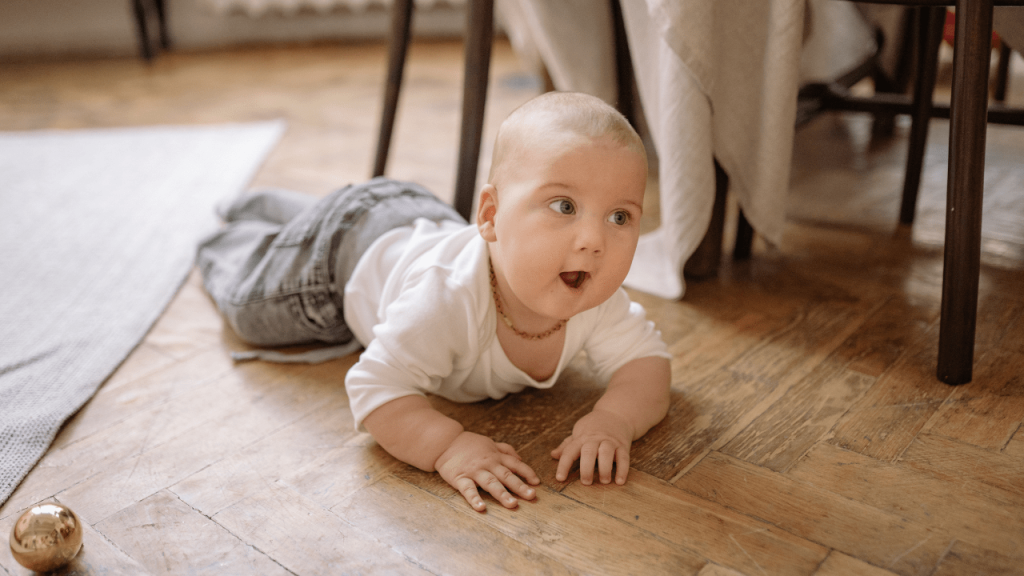
As your baby reaches the seven- to eight-month mark, they enter a period of remarkable physical and cognitive development. This stage is characterized by the exciting milestone of crawling, as well as an increase in curiosity about their surroundings. These developments signify your baby’s growing independence and their desire to explore the world around them.
Crawling is a significant milestone that demonstrates your baby’s increased muscle strength, coordination, and motor skills. By this age, many babies begin to push themselves up on their hands and knees, rocking back and forth as they prepare to move. This precursor to crawling helps your baby develop the necessary upper body strength and balance. Once they master this movement, they typically start crawling forward, using alternating hand and knee movements to propel themselves. Crawling is not only a physical achievement but also an essential step in your baby’s gross motor skill development, laying the groundwork for future milestones such as standing and walking.
The process of crawling enhances your baby’s spatial awareness and problem-solving skills. As they move across the floor, they begin to understand distance, depth, and obstacles in their path. This newfound mobility allows them to explore their environment more freely, which in turn stimulates their cognitive development. Crawling also encourages your baby to engage in cross-lateral movements, where they use opposite limbs to move forward. This type of movement is crucial for brain development, as it promotes communication between the two hemispheres of the brain.
As your baby becomes more mobile, their curiosity about the world around them intensifies. They will likely begin to investigate objects and areas that were previously out of reach, driven by a natural desire to explore. This curiosity is a sign of your baby’s developing cognitive skills and growing awareness of their environment. You might notice your baby showing increased interest in objects with different shapes, sizes, and textures, or trying to understand how things work by manipulating them. This exploration is a key part of their sensory development, as it allows them to learn through touch, sight, and sometimes even taste.
To support your baby’s growing curiosity, it’s important to create a safe and stimulating environment. Babyproofing your home is essential at this stage, as your baby’s ability to move around increases their exposure to potential hazards. Cover electrical outlets, secure heavy furniture, and ensure that small objects that could be a choking hazard are out of reach. Providing a variety of safe toys that encourage exploration, such as stacking blocks, soft balls, or toys with moving parts, can help satisfy your baby’s curiosity while also supporting their fine motor skill development.
During this period, your baby’s social development also takes a leap forward. As they crawl and explore, they may begin to seek out your company or that of other family members, enjoying the interaction that comes from shared play. They might crawl toward you, seeking attention or wanting to share their discoveries. This behavior reflects their growing emotional development and the deepening bond between you and your baby. Engaging in interactive play, such as crawling together or playing peekaboo, can strengthen this bond and support their social skills.
Additionally, the seven- to eight-month period is when many babies begin to experiment with babbling, combining consonants and vowels to form early speech sounds like “mamama” or “dadada.” This language development often coincides with their increased mobility and curiosity, as they express excitement or frustration with their new abilities. Encouraging your baby’s vocalizations by responding to their babbles and talking to them frequently can support their language development and help them learn the rhythm and flow of conversation.
In summary, the seven- to eight-month stage is a time of dynamic growth and exploration for your baby. Crawling opens up a new world of possibilities, allowing them to satisfy their natural curiosity and engage more fully with their environment. By providing a safe and stimulating space for exploration, encouraging social interaction, and supporting their early language skills, you’re helping your baby develop the physical, cognitive, and emotional foundations they’ll build on as they continue to grow and learn.
Ten to Eleven Months: First Words and First Steps
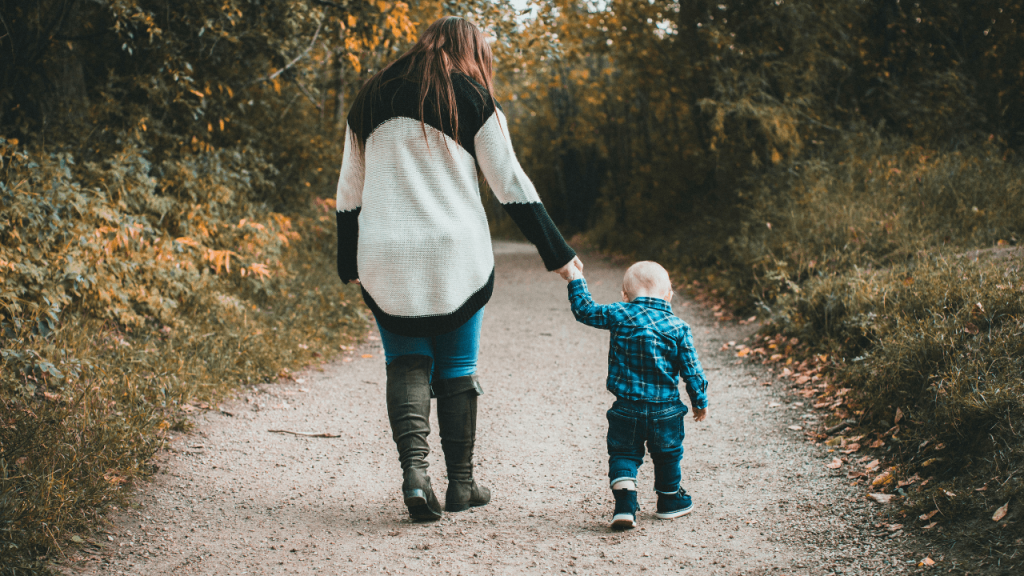
As your baby approaches the ten- to eleven-month mark, they are likely on the brink of two major milestones: first words and first steps. These achievements mark significant progress in your baby’s language development and gross motor skills, signaling their transition from infancy to toddlerhood.
First words are a momentous milestone, reflecting your baby’s growing ability to understand and use language. By ten to eleven months, many babies can say simple words like “mama,” “dada,” or “baba.” These early words are usually used to refer to their parents or favorite objects, and they often arise from the babbling sounds that your baby has been experimenting with over the past few months. The ability to produce these words demonstrates your baby’s cognitive development and their understanding that sounds can represent specific people or things.
Your baby’s first words are supported by their growing receptive language skills, meaning they can understand more words than they can speak. For example, they might recognize the names of familiar people, objects, or actions, and they may respond to simple instructions like “come here” or “wave bye-bye.” This understanding is a crucial part of their overall language acquisition and lays the foundation for more complex speech as they grow. To encourage your baby’s speech development, engage in frequent conversations, read aloud to them, and label objects and actions as you go about your daily routine. These activities help to reinforce their understanding of language and encourage them to use their own words.
At the same time, your baby is likely beginning to take their first steps. This is one of the most exciting physical milestones, marking the transition from crawling to walking. Around this age, many babies start to pull themselves up to a standing position, using furniture or an adult’s hands for support. This is the beginning of cruising, where they move around while holding onto objects for balance. As your baby’s leg muscles strengthen and their balance improves, they may start to let go and take a few tentative steps on their own. These early steps are often wobbly and unsteady, but they are a clear sign that your baby is developing the coordination and muscle strength needed for independent walking.
The journey to walking is a complex process that involves not just physical strength, but also spatial awareness and problem-solving skills. Your baby is learning to judge distances, navigate obstacles, and control their movements to stay upright. This period of motor skill development is crucial for building the confidence and ability to walk independently. To support your baby’s first steps, provide them with a safe environment where they can practice standing and walking. Offering push toys or sturdy furniture they can hold onto while cruising can also help build their confidence and balance.
As your baby begins to walk, their world expands, allowing them to explore more of their environment and engage in new types of play. This newfound mobility enhances their curiosity and desire to explore, which in turn stimulates their cognitive development. Walking also provides opportunities for social development, as your baby can now follow you around, engage in more interactive play, and even begin to participate in simple games that involve movement.
During this stage, it’s important to continue nurturing your baby’s language skills alongside their physical development. Encourage their attempts at speech by repeating words back to them, praising their efforts, and introducing new vocabulary through books, songs, and everyday conversation. Combining physical activities with verbal interactions, such as naming objects they walk toward or describing actions as they perform them, helps to reinforce the connection between language and movement.
In summary, the ten- to eleven-month period is a time of incredible growth and achievement for your baby. As they take their first steps and utter their first words, they are not only reaching important developmental milestones but also gaining the confidence and skills that will carry them into toddlerhood. By providing a supportive and stimulating environment, you can help your baby thrive as they embark on this exciting new phase of their development.
Twelve Months: A Full Year of Growth
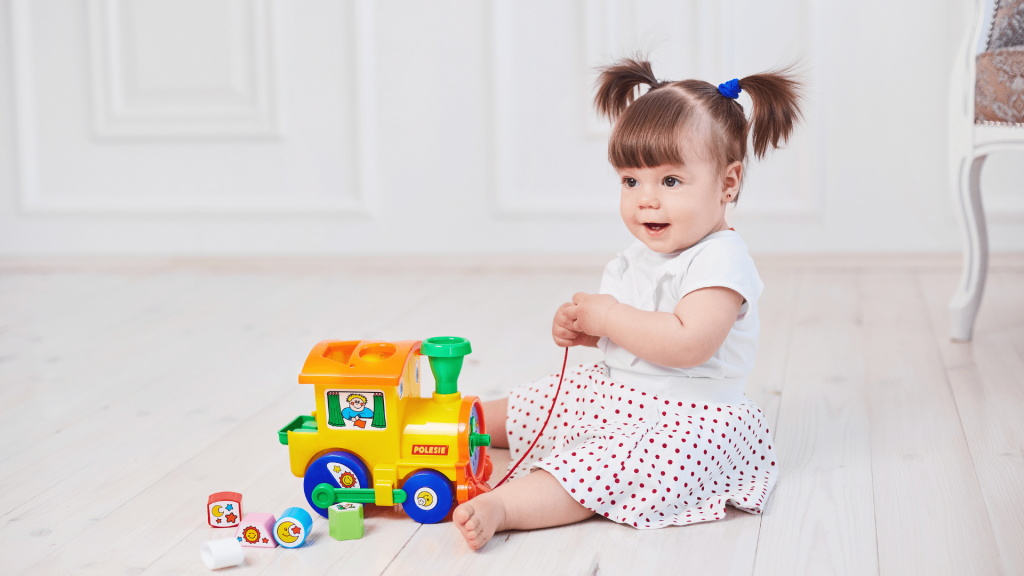
Reaching the twelve-month milestone is a momentous occasion, marking the completion of your baby’s first year of life. This period is a time of reflection on the incredible growth and development your baby has experienced over the past twelve months. At this stage, your baby is likely showing signs of greater independence, enhanced motor skills, and increased cognitive abilities, all of which are crucial for their journey into toddlerhood.
By twelve months, your baby’s physical development has progressed significantly. Many babies are either walking independently or are very close to taking their first unaided steps. Walking is a remarkable achievement that reflects not only your baby’s strengthened muscle coordination but also their improved balance and spatial awareness. With their new ability to walk, your baby can explore their environment more freely, which in turn fuels their curiosity and desire to learn. This mobility is essential for fostering independence, as your baby can now move from one place to another without assistance, further developing their confidence and autonomy.
Your baby’s fine motor skills have also become more refined by this age. They can likely grasp small objects between their thumb and forefinger with a pincer grip, a skill that is crucial for tasks such as feeding themselves, turning the pages of a book, or stacking blocks. These activities not only help develop hand-eye coordination but also contribute to their overall cognitive development, as they learn cause and effect through play.
In terms of cognitive development, the twelve-month mark often brings a surge in your baby’s ability to understand and interact with the world around them. They are likely beginning to understand more complex concepts, such as object permanence—the understanding that objects continue to exist even when out of sight. This cognitive leap is reflected in your baby’s interest in games like peekaboo or hiding and finding objects, which they find endlessly fascinating.
Your baby’s language development also continues to advance. By twelve months, they may have a small vocabulary of a few words, such as “mama,” “dada,” and “bye-bye,” and they can often understand and respond to simple commands like “give me the toy” or “come here.” This stage is crucial for receptive language skills, as your baby is rapidly absorbing the words and phrases they hear from you and others around them. Encouraging this development through regular conversations, reading, and singing can greatly enhance their language skills, setting the stage for more complex speech in the coming months.
Socially, your twelve-month-old is becoming more aware of their relationships with others. They may start to show preferences for certain people, often demonstrating attachment behaviors such as clinging to you in unfamiliar situations or seeking comfort from you when upset. This is a normal part of their emotional development and reflects their growing understanding of the social world. At this stage, your baby may also start to engage in more interactive play with others, such as playing simple games or imitating actions they see from adults or other children. These interactions are essential for developing social skills and learning how to communicate effectively with others.
Nutrition also plays a significant role at twelve months, as your baby transitions from a primarily milk-based diet to a more varied diet that includes a wider range of solid foods. By this age, many babies are eating three meals a day with snacks in between, enjoying a variety of fruits, vegetables, proteins, and grains. This shift in diet is important for providing the necessary nutrients for continued growth and development. Encouraging healthy eating habits during this period, such as offering a balanced diet and introducing a variety of flavors and textures, helps set the foundation for lifelong nutrition.
The twelve-month milestone is also an ideal time for routine health checks. Your pediatrician will assess your baby’s growth, discuss their developmental milestones, and address any concerns you may have. Regular check-ups ensure that your baby is on track with their growth and development and provide an opportunity to receive guidance on topics such as nutrition, sleep, and safety.
In conclusion, the first twelve months of your baby’s life are a period of extraordinary growth and development. From mastering gross and fine motor skills to advancing in cognitive, language, and social abilities, your baby has achieved a tremendous amount in just one year. As you celebrate this milestone, it’s important to continue providing a supportive and nurturing environment that encourages their ongoing development. The foundation you have built during this first year will serve as a strong base for the exciting stages of growth and learning that lie ahead.
Conclusion: Understanding Developmental Milestones in Your Baby’s First Year
Your baby’s first year is filled with countless developmental milestones, each one a testament to their growth and progress. By understanding these milestones and how to support your baby at each stage, you can help them thrive during this critical period. Keep celebrating the small victories, stay patient through the challenges, and remember that every baby develops at their own pace. Here’s to a happy, healthy, and wonderful first year with your little one!
